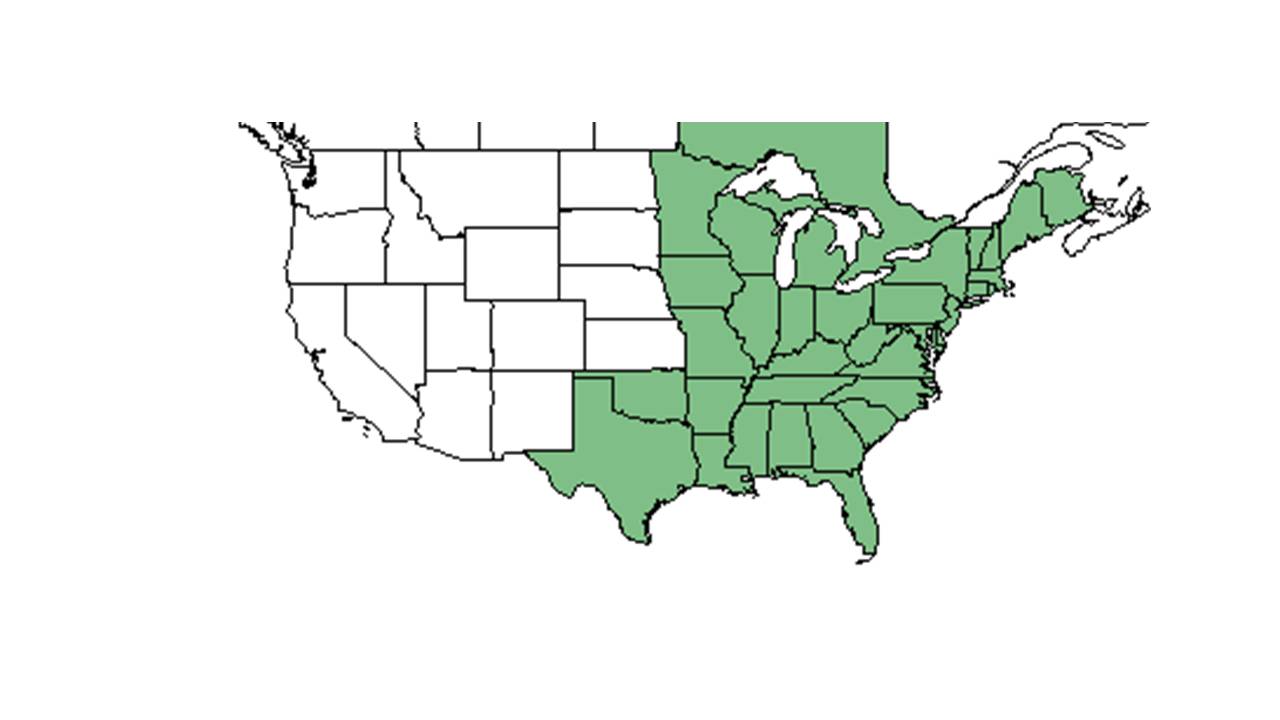Dichanthelium dichotomum
| Dichanthelium dichotomum | |
|---|---|

| |
| Scientific classification | |
| Kingdom: | Plantae |
| Division: | Magnoliophyta - Flowering plants |
| Class: | Liliopsida – Monocotyledons |
| Order: | Cyperales |
| Family: | Poaceae ⁄ Gramineae |
| Genus: | Dichanthelium |
| Species: | D. dichotomum |
| Binomial name | |
| Dichanthelium dichotomum (L.) Gould | |

| |
| Natural range of Dichanthelium dichotomum from USDA NRCS Plants Database. | |
Contents
Description
Common Name: cypress panicgrass
Synonym Name: Panicum dichotomum L.
Dichanthelium dichotomum is a perennial graminoid.
Distribution
Ecology
D. dichotomum was among the species that responded positively to reduction of woody vegetation using triclopyr herbicide[1].
Habitat
It can live in wet areas[2]. Dichanthelium dichotomum var. dichotomum can be found in disturbed sites[3].Dichanthelium dichotomum var. ensifolium can live in wet pine savannas[2]. It can also be found in longleaf pine communities[4], loblolly pine communities[1], and flatwoods communities [5].
Phenology
Seed dispersal
Dichanthelium dichotomum was common in the seed bank of a Florida flatwoods community[5] Dichanthelium dichotomum var. nitidum was found in the seed bank of both disturbed and undisturbed sites[3]
Seed bank and germination
From observing the results of Taft's prescribed burns, fire seems to be required for germination[6].
Fire ecology
It is fire-tolerant[2] Following an early, moderate-intensity dormant-season burn (November) in a dry sandstone barrens, D. dichotomum increased rapidly, probably as a result of the widespread stimulation of the seed bank. It was still observed on site six years after the burn[6].
Pollination
Use by animals
Diseases and parasites
Conservation and Management
Cultivation and restoration
Photo Gallery
References and notes
- ↑ 1.0 1.1 Miller, J. H., R. S. Boyd, et al. (1999). "Floristic diversity, stand structure, and composition 11 years after herbicide site preparation." Canadian Journal of Forest Research 29: 1073-1083.
- ↑ 2.0 2.1 2.2 Brewer, J. S., D. J. Baker, et al. (2011). "Carnivory in plants as a beneficial trait in wetlands." Aquatic Botany 94: 62-70.
- ↑ 3.0 3.1 Cohen, S., R. Braham, et al. (2004). "Seed bank viability in disturbed longleaf pine sites." Restoration Ecology 12: 503-515.
- ↑ Glitzenstein, J. S., D. R. Streng, et al. (2003). "Fire frequency effects on longleaf pine (Pinus palustris, P.Miller) vegetation in South Carolina and northeast Florida, USA." Natural Areas Journal 23: 22-37 Cohen, S., R. Braham, et al. (2004). "Seed bank viability in disturbed longleaf pine sites." Restoration Ecology 12: 503-515.
- ↑ 5.0 5.1 Kalmbacher, R., N. Cellinese, et al. (2005). "Seeds obtained by vacuuming the soil surface after fire compared with soil seedbank in a flatwoods plant community." Native Plants Journal 6: 233-241.
- ↑ 6.0 6.1 Taft, J. B. (2003). "Fire effects on community structure, composition, and diversity in a dry sandstone barrens." Journal of the Torrey Botanical Society 130: 170-192.